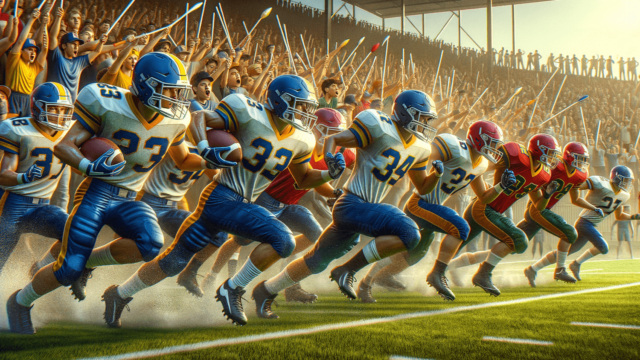
A football scrimmage typically lasts between 90 minutes to 2 hours, including warm-up and cool-down periods. Factors like specific coaching objectives, team needs, and skill development may affect the duration.
Understanding Football Scrimmages
A football scrimmage is an informal practice game played between two teams, assisting coaches in evaluating players’ techniques, strategies, and overall team performance. The duration of a scrimmage can vary depending on the objectives and team requirements.
Typical Scrimmage Duration
Usually, a football scrimmage lasts between 90 minutes and 2 hours, which includes warm-up and cool-down periods, along with water breaks for the players. However, this is not an absolute rule, and factors like coaching goals, team needs, and skill development can affect the timeframe.
Coaching Objectives
Coaches may have specific aims in mind when organizing a scrimmage, such as analyzing combinations between players, solving tactical issues, or giving new players a chance to showcase their abilities. If coaches aim to accomplish multiple objectives, the scrimmage may last longer.
Team Needs
The team’s needs and current situation play a significant role in determining the length of a scrimmage. For instance, during the pre-season, coaches may schedule longer scrimmages to build fitness and get players accustomed to their tactical formation. In contrast, during the main season, training sessions may focus on shorter, more targeted scrimmages to refine team strategies.
Skill Development
Another factor influencing scrimmage duration is the stage of the players’ skill development. Younger or less experienced athletes may require more time on the field to understand game concepts and hone their skills. In these cases, scrimmages might last longer, giving players more time to adapt and demonstrate their abilities.
Benefits of Football Scrimmages
Scrimmages are valuable not only for the players but also for coaches and other team members. They provide practice implementing tactics, evaluating strategies, identifying areas of improvement, and building team chemistry. As scrimmages lack the pressure of formal matches, players can learn and rectify errors in a more laid-back environment.
Adjusting Scrimmage Duration
Coaches can adjust the duration of a football scrimmage to achieve specific objectives or maintain players’ interest and focus. They can try different formats, like full-field scrimmages, small-sided games, or splitting the team into multiple small teams. Experimenting with the length and format of scrimmages can provide coaches with unique insights into their team’s strengths and areas for improvement.
Rest and Recovery
While scrimmages are beneficial for skill development, coaches must also consider the importance of player rest and recovery. To avoid injuries and overtraining, it is crucial to balance intense scrimmage sessions with appropriate rest periods. This ensures optimal player engagement and maintains a healthy squad throughout the season.
Mixing Competitive and Fun Elements
Incorporating fun elements into a scrimmage can help maintain player motivation and enjoyment. This not only enhances skill development, but also builds team rapport. Fun games, challenges, and rewards can add the necessary element of camaraderie that often translates into better performance on the field during real match scenarios.
Monitoring and Feedback
As scrimmages provide valuable information on individual and team performance, coaches should use monitoring and feedback techniques to assess and address identified issues. Video analysis, real-time feedback, and post-scrimmage debriefing can function as tools for players to understand their strengths and weaknesses. This empowers them to improve specific aspects of their game and contribute to the team’s overall success.
FAQ Section
In this section, we answer some frequently asked questions regarding football scrimmages and their related aspects. Feel free to explore the information provided to gain a deeper understanding of the topic.
What is the optimal scrimmage-to-rest ratio for a team during the season?
There is no one-size-fits-all answer to this, as the optimal scrimmage-to-rest ratio depends on various factors such as the team’s fitness level, individual players’ recovery time, and schedule. As a general guideline, coaches should provide players with at least one rest day per week and schedule scrimmages to ensure adequate recovery, especially during periods of intense training or competition.
How can coaches assess whether a scrimmage is effective?
An effective scrimmage should result in improved team performance, tactical understanding, and individual skill development. Coaches can assess scrimmage effectiveness by monitoring individual and team progress using video analysis, player performance data, and goal achievement. Additionally, player feedback and team dynamics can assist in evaluating the efficacy of scrimmage sessions.
Can coaches organize scrimmages against other teams?
Yes, coaches can arrange scrimmages against other teams to provide their players with a different challenge and simulate a real match experience. Playing against new opposition can help players adapt to different styles of play and test the team’s ability to overcome tactical challenges. Such scrimmages can also work as a networking opportunity for players and staff.
How can I help my players maintain focus during a scrimmage?
Maintaining player focus during a scrimmage can be accomplished by setting clear goals, incorporating competitive and fun elements, and providing real-time feedback. To keep players engaged and motivated, coaches should create an environment where players can improve their skills, refine tactics, and build camaraderie, all while enjoying the process of learning and playing.
In what ways can small-sided games be used within a scrimmage?
Small-sided games (SSG) can serve as an important part of a scrimmage by providing players with more touches on the ball and increased decision-making opportunities. SSGs can work as individual drills or be integrated into the main scrimmage, focusing on specific aspects such as attacking, defending, or transition play. They also contribute to improved player decision-making, teamwork, and problem-solving abilities on the field.
Featured Posts
- No pillar pages found.





